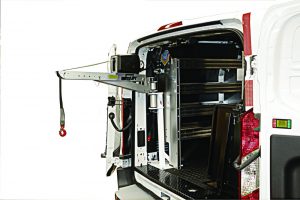The WorkMaster secures the tools of your trade unlike any other enclosed service body. Constructed with steel, built like a vault, the “walk-in” WorkMaster is designed for heavier-duty cutaway vans…and we have been known to mount them on a chassis or two. The WorkMaster is constructed in different lengths and heights to meet your every tool, material storage, and interior height (up to 6’3″) requirement. Need to carry more than your typical van? This is your truck!
- Tightest security system in town, featuring double-bit keys and a Master Lock internal locking system
- Modern gas shocks on each side opening door to keep them open during loading and unloading
- Rear side access door for storage of conduit or other long (10-ft.) materials
- 12" step bumper and side-wall grab handles for ease of entrance into the bed
- Interior ladder storage on hooks mounted along inside shelf
- Weights up to 300 lbs. lighter than competing brands using FRP
- Weather shield system around locks, doors, and hingles, preventing leaks and securing the tools of your trade. Neoprene door seals, water-proof gaskets, self-sealing stainless steel rivets, and silky smooth three-point door latches with Teflon glides.
| http://harbortruckandvan.com/ |






